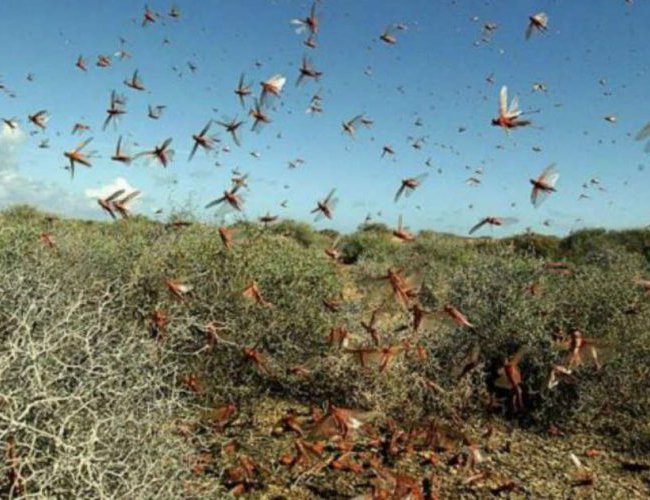
At a time when the country is facing COVID-19 crisis, the Locusts Information Centre has warned that a large swarm of locusts is likely to enter Nepal from India over the next couple of days. They have already destroyed billions of rupees worth of crops in 26 districts.
The first batch of locusts, which entered Nepal, has destroyed crops in various parts of the country. Almost 200000 locusts also entered Kathmandu and some of them moved to Nuwakot.
According to government officials, the locusts have damaged crops, mostly maize, and vegetables in mainly four districts Makwanpur, Dang, Pyuthan and Palpa.
“They have reached 26 districts across the country,” said Ram Krishna Subedi, information officer of Plant Quarantine and Pest Management Centre under the Ministry of Agriculture and Livestock Development recently.
“The locust swarms that first entered Nepal,” said Subedi, who is leading the Locust Information Centre established at Plant Quarantine and Pest Management Centre.
A slightly bigger group of locusts caused damages in some areas of Dang district. A swarm of locusts damaged rice and vegetables in Gadawa and Tulsipur areas of Dang district. The locusts damaged crops slightly in a few areas in Chitwan, Kapilvastu, Rupandehi and Kailali districts.
“No new swarm of locusts has entered Nepal except for the one that entered on a recent Saturday morning. But there is still a chance that other groups of locusts may arrive in Nepal,” he said.
All the local and state governments are in an alert state by mobilizing technical teams to control the possible losses the locusts can cause.
According to the centre, the swarm of locusts is headed towards Darjeeling from Bhagalpur and Motihari in Bihar. As the swarm is likely to enter Nepal from there, the centre has issued a notice directing the authorities concerned to be on high alert.
“The swarm with about two million locusts might affect Tarai and lower hilly regions of the country. If it enters the country and doesn’t split up, it will be difficult for us to control it,” said Subedi, coordinator of the centre.
According to the centre, 24 small groups of locusts have been found in the country so far. More than three million locusts have entered Nepal from India and have fanned out to more than 30 districts. Even though locusts have affected fewer crops so far, the centre has requested stakeholders to do their best to control the pests.
On June 27, locusts were sighted in Bara and Parsa. Prior to that, locusts were seen in Nepal in 1962. Back then, the swarm had invaded crops in Kathmandu, Nuwakot, Dhading and a few other districts, inflicting much damage to crops.
The first swarm of locusts, which had entered the country, has already wrought havoc on a number of districts, especially in the Tarai. The locusts have quickly spread to over two dozens of districts, including districts as high as Khotang, Okhaldhunga, Rukum West, Mustang and Solukhumbu.
According to experts, these large swarms are regularly breaking off and forming smaller groups and flying haphazardly in the sky, according to the Locust Information Centre at the Agriculture Ministry, formed to keep track of the swarms and find ways to contain them.
This change in wind direction is likely to coincide with the locust swarms in India’s Bhagalpur and Motihari and another group flying towards Champaran district from Kushinagar. These swarms are likely to enter Nepal, according to an alert from the Plant Quarantine and Pesticide Management Centre.
According to the Food and Agriculture Organization of the United Nations, the desert locust (Schistocerca gregaria) is considered the most dangerous of all migratory pest species in the world.
- FOREIGN EXCHANGE: Largest Deposit
- Jul 22, 2024
- IMF: Approval Of SDR
- Jul 22, 2024
- NEPAL-KOREA RELATIONS: Fifty-Years Of Warm Relations
- May 31, 2024
- NEPAL-BRITAIN: Centenary Celebration
- May 31, 2024
- POLITCS: Forming New Alliances
- May 27, 2024
















